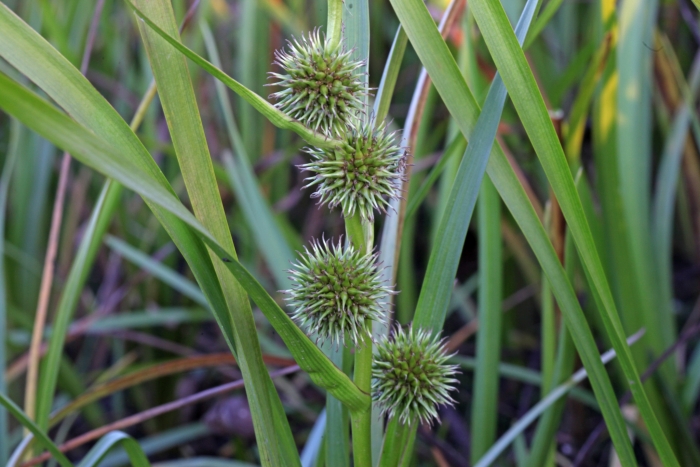European Bur-Reed
(Sparganium emersum)
European Bur-Reed (Sparganium emersum)
/
/

Nina Filippova
CC BY 4.0
Image By:
Nina Filippova
Recorded By:
Copyright:
CC BY 4.0
Copyright Notice:
Photo by: Nina Filippova | License Type: CC BY 4.0 | License URL: http://creativecommons.org/licenses/by/4.0/ | Rights Holder: Nina Filippova | Publisher: iNaturalist | Date Created: 2011-09-11T19:19:05-07:00 |

























Estimated Native Range
Summary
Sparganium emersum, commonly known as European bur-reed or unbranched bur-reed, is a perennial herb native to temperate and subarctic regions of the Northern Hemisphere, including the northern latitudes of Eurasia and North America. It is typically found in shallow water bodies such as ponds, lakes, slow-moving streams, and marshes, where it forms dense stands. This aquatic plant can produce both floating and erect leaves, with the floating leaves being long and strap-like, while the erect leaves are stiffer and shorter. European bur-reed reaches a height of up to 3 feet (1 meter) and is characterized by its monoecious nature, with separate male and female spherical inflorescences on the same plant. The inflorescences are greenish-white and appear in summer, with the male flowers situated above the female flowers on the stem.
European bur-reed is valued for its ability to stabilize shorelines and provide habitat for aquatic wildlife. It is used in water gardens and for naturalizing in wetland areas. In cultivation, it requires full sun to part shade, consistently moist to wet soil, and can tolerate a range of soil types as long as they are saturated with water. While generally low-maintenance, it can spread vigorously in ideal conditions and may need to be managed to prevent it from dominating a space. There are no major disease or pest issues, but it can be sensitive to water pollution.CC BY-SA 4.0
European bur-reed is valued for its ability to stabilize shorelines and provide habitat for aquatic wildlife. It is used in water gardens and for naturalizing in wetland areas. In cultivation, it requires full sun to part shade, consistently moist to wet soil, and can tolerate a range of soil types as long as they are saturated with water. While generally low-maintenance, it can spread vigorously in ideal conditions and may need to be managed to prevent it from dominating a space. There are no major disease or pest issues, but it can be sensitive to water pollution.CC BY-SA 4.0
Plant Description
- Plant Type: Herb
- Height: 1-1.3 feet
- Width: 0.25-0.5 feet
- Growth Rate: Moderate
- Flower Color: Green, White, Yellow
- Flowering Season: Spring, Summer, Fall
- Leaf Retention: Deciduous
Growth Requirements
- Sun: Full Sun, Part Shade
- Water: High, Aquatic
- Drainage: Standing
Common Uses
Erosion Control, Low Maintenance, Water Garden
Natural Habitat
Temperate and subarctic regions of the Northern Hemisphere, including shallow water bodies such as ponds, lakes, slow-moving streams, and marshes
Other Names
Common Names: Unbranched Bur-Reed, Simplestem Bur-reed
Scientific Names: , Sparganium emersum, Sparganium acaule, Sparganium angustifolium subsp. emersum, Sparganium angustifolium var. chlorocarpum, Sparganium angustifolium var. multipedunculatum, Sparganium chlorocarpum, Sparganium chlorocarpum f. acaule, Sparganium chlorocarpum var. acaule, Sparganium chlorocarpum var. typicum
GBIF Accepted Name: